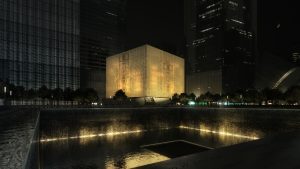summit
20 Years After 9/11: Commemorating History and Building for the Future

This month, as we mark 20 years since the attacks of 9/11, I’ll join New Yorkers and people from around the world in listening to the reading of the names at the World Trade Center. The ceremony helps fulfill our obligation to honor the lives of those who were killed and educate people about what happened on 9/11 and how we responded, a duty that only grows more important with each passing year.
That same sense of duty drove the creation of the 9/11 Memorial and Museum at the World Trade Center, and it inspired the many individuals, companies, and organizations whose support helped make both possible. The Memorial and Museum are testimony to the spirit of common purpose that we saw after 9/11, and to the power of philanthropy: Private funding played a vital part in their construction and remains essential to their operation.
This year, people gathered at the Memorial or watching on video will also see a new structure rising, the final piece in the rebuilding of the site: The World Trade Center Performing Arts Center. An arts center has always been part of our vision for the redevelopment of the site, because of the critically important – and often underappreciated – role that the arts play in our communities.
The arts bring life and energy to neighborhoods, and they bring people from different backgrounds together and build bridges of tolerance and empathy by helping us to see and understand others’ points of view. The arts also attract visitors who support local businesses and generate revenue that cities need to provide essential services that residents depend on. The World Trade Center Performing Arts Center will bring all of those benefits, and with public spaces that are open for all, and meeting spaces for local groups and educational programming, it will also serve as an anchor for the community. It will be a home for all the performing arts, as well as film, and commission new pieces by great artists. And its innovative design will make it unlike any other venue, with flexible performance spaces that can be specially configured to fit the specific needs of different productions and an extraordinary translucent marble exterior.
During our time in City Hall, our administration was a big believer in this project, and I have since worked to help bring it to life, including by serving as chairman of the board. Like the Memorial and Museum, the creation of the Performing Arts Center was driven by the public but it depends upon private donors to survive and thrive. Thanks to their generosity, construction has progressed well: This summer, we held a topping off ceremony to mark completion of the structural steelwork.
While the finish line is in sight, we still have work to do to raise the funds necessary to complete the project. Many have generously contributed, because they know that it is a way to make a real and lasting difference at a critical moment. They can take pride in knowing they played a role in New York’s recovery from the pandemic – and that they helped us uphold our commitment to finish rebuilding the World Trade Center site, which is so important not just to New York, but to our country and our world.
Today, cities all over the country and the world face enormous economic and social challenges because of the coronavirus pandemic. Philanthropy has a valuable role to play in helping cities recover and build strong futures, including by supporting the arts – and that has certainly been true of New York. Today there are far more residents, workers, and visitors in Lower Manhattan than there were on September 10th, 2011.
The new Performing Arts Center at the World Trade Center will help write the next chapter in the rebirth of Lower Manhattan – and help write another comeback story for New York. But institutions like the Performing Arts Center and the Memorial and Museum will continue to require sustained and generous support from philanthropic organizations and donors – and from the next generation of civic leaders.
Photo Credit : Luxigon/The Ronald O. Perelman Performing Arts Center
